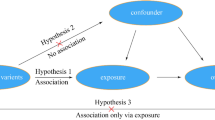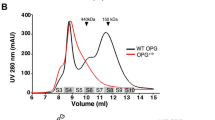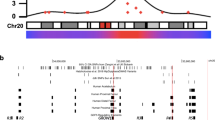Abstract
Osteoarthritis is the most common form of human arthritis. We investigated the potential role of asporin, an extracellular matrix component expressed abundantly in the articular cartilage of individuals with osteoarthritis, in the pathogenesis of osteoarthritis. Here we report a significant association between a polymorphism in the aspartic acid (D) repeat of the gene encoding asporin (ASPN) and osteoarthritis. In two independent populations of individuals with knee osteoarthritis, the D14 allele of ASPN is over-represented relative to the common D13 allele, and its frequency increases with disease severity. The D14 allele is also over-represented in individuals with hip osteoarthritis. Asporin suppresses TGF-β–mediated expression of the genes aggrecan (AGC1) and type II collagen (COL2A1) and reduced proteoglycan accumulation in an in vitro model of chondrogenesis. The effect on TGF-β activity is allele-specific, with the D14 allele resulting in greater inhibition than other alleles. In vitro binding assays showed a direct interaction between asporin and TGF-β. Taken together, these findings provide another functional link between extracellular matrix proteins, TGF-β activity and disease, suggesting new therapeutic strategies for osteoarthritis.
This is a preview of subscription content, access via your institution
Access options
Subscribe to this journal
Receive 12 print issues and online access
$209.00 per year
only $17.42 per issue
Buy this article
- Purchase on SpringerLink
- Instant access to full article PDF
Prices may be subject to local taxes which are calculated during checkout







Similar content being viewed by others
References
Felson, D.T. et al. The prevalence of knee osteoarthritis in the elderly: the Framingham Osteoarthritis Study. Arthritis Rheum. 30, 914–918 (1987).
Kellgren, J.H. & Lawrence, J.S. Radiological assessment of osteoarthrosis. Ann. Rheum. Dis. 16, 494–502 (1957).
Kellgren, J.H., Lawrence, J.S. & Bier, F. Genetic factors in generalized osteoarthrosis. Ann. Rheum. Dis. 22, 237–255 (1963).
Spector, T.D., Cicuttini, F., Baker, J., Loughlin, J. & Hart, D. Genetic influences on osteoarthritis in women: A twin study. BMJ 312, 940–943 (1996).
Spector, T.D. & MacGregor, A.J. Risk factors for osteoarthritis: genetics. Osteoarthritis Cartilage 12, S39–S44 (2004).
Loughlin, J. Genetic epidemiology of primary osteoarthritis. Curr. Opin. Rheumatol. 13, 111–116 (2001).
Loughlin, J., Dowling, B., Mustafa, Z. & Chapman, K. Association of the interleukin-1 gene cluster on chromosome 2q13 with knee osteoarthritis. Arthritis Rheum. 46, 1519–1527 (2002).
Smith, A.J.P. et al. Extended haplotypes and linkage disequilibrium in the IL1R1-IL1A-IL1B-IL1RN gene cluster: association with knee osteoarthritis. Genes Immun. 5, 451–460 (2004).
Grimaud, E., Heymann, D. & Redini, F. Recent advances in TGF-β effects on chondrocyte metabolism Potential therapeutic roles of TGF-β in cartilage disorders. Cytokine Growth Factor Rev. 13, 241–257 (2002).
Lorenzo, P. et al. Identification and characterization of asporin. a novel member of the leucine-rich repeat protein family closely related to decorin and biglycan. J. Biol. Chem. 276, 12201–12211 (2001).
Henry, S.P. et al. Expression pattern and gene characterization of asporin. a newly discovered member of the leucine-rich repeat protein family. J. Biol. Chem. 276, 12212–12221 (2001).
Ameye, L. & Young, M.F. Mice deficient in small leucine-rich proteoglycans: novel in vivo models for osteoporosis, osteoarthritis, Ehlers-Danlos syndrome, muscular dystrophy, and corneal diseases. Glycobiology 12, 107R–116R (2002).
Gill, M.R., Oldberg, A. & Reinholt, F.P. Fibromodulin-null murine knee joints display increased incidences of osteoarthritis and alterations in tissue biochemistry. Osteoarthritis Cartilage 10, 751–757 (2002).
Ameye, L. et al. Abnormal collagen fibrils in tendons of biglycan/fibromodulin-deficient mice lead to gait impairment, ectopic ossification, and osteoarthritis. FASEB J. 16, 673–680 (2002).
Haga, H., Yamada, R., Ohnishi, Y., Nakamura, Y. & Tanaka, T. Gene-based SNP discovery as part of the Japanese Millennium Genome Project: identification of 190,562 genetic variations in the human genome. J. Hum. Genet. 47, 605–610 (2002).
Ikeda, T. et al. Identification of sequence polymorphisms in two sulfation-related genes, PAPSS2 and SLC26A2, and an association analysis with knee osteoarthritis. J. Hum. Genet. 46, 538–543 (2001).
Shukunami, C. et al. Chondrogenic differentiation of clonal mouse embryonic cell line ATDC5 in vitro:differentiation-dependent gene expression of parathyroid hormone (PTH)/PTH-related peptide receptor. J. Cell Biol. 133, 457–468 (1996).
Shukunami, C. et al. Cellular hypertrophy and calcification of embryonal carcinoma-derived chondrogenic cell line ATDC5 in vitro. J. Bone Miner. Res. 12, 1174–1188 (1997).
Watanabe, H., de Caestecker, M.P. & Yamada, Y. Transcriptional cross-talk between Smad, ERK1/2, and p38 mitogen-activated protein kinase pathways regulates transforming growth factor-β-induced aggrecan gene expression in chondrogenic ATDC5 cells. J. Biol. Chem. 276, 14466–14473 (2001).
Shukunami, C., Ohta, Y., Sakuda, M. & Hiraki, Y. Sequential progression of the differentiation program by bone morphogenetic protein-2 in chondrogenic cell line ATDC5. Exp. Cell Res. 241, 1–11 (1998).
Hildebrand, A. et al. Interaction of the small interstitial proteoglycans biglycan, decorin, and fibromodulin with transforming growth factor β. Biochem. J. 302, 527–534 (1994).
van Beuningen, H.M., van der Kraan, P.M., Aruntz, O.J. & van den Berg, W.B. Transforming growth factor-β1 stimulates articular chondrocyte proteoglycan synthesis and induces osteophyte formation in the murine knee joint. Lab. Invest. 71, 279–290 (1994).
Scharstuhl, A. et al. Inhibition of endogenous TGF-β during experimental osteoarthritis prevents osteophyte formation and impairs cartilage repair. J. Immunol. 169, 507–514 (2002).
Serra, R. et al. Expression of a truncated, kinase-defective TGF-β type II receptor in mouse skeletal tissue promotes terminal chondrocyte differentiation and osteoarthritis. J. Cell Biol. 139, 541–552 (1997).
Yang, X. et al. TGF-β/Smad3 signals repress chondrocyte hypertrophic differentiation and are required for maintaining articular cartilage. J. Cell Biol. 153, 35–46 (2001).
Neptune, E.R. et al. Dysregulation of TGF-β activation contributes to pathogenesis in Marfan syndrome. Nat. Genet. 33, 407–411 (2003).
Border, W.A. et al. Natural inhibitor of transforming growth factor-β protects against scarring in experimental kidney disease. Nature 360, 361–364 (1992).
Isaka, Y. et al. Gene therapy by skeletal muscle expression of decorin prevents fibrotic disease in rat kidney. Nat. Med. 2, 418–423 (1996).
Yang, V.W., LaBrenz, S.R., Rosenberg, L.C., McQuillan, D.J. & Hook, M. Decorin is a Zn2+ metalloprotein. J. Biol. Chem. 274, 12454–12460 (1999).
Dugan, T.A., Yang, V.W., McQuillan, D.J. & Hook, M. Decorin binds fibrinogen in a Zn2+-dependent interaction. J. Biol. Chem. 278, 13655–13662 (2003).
Singh, K. et al. Calcium-binding properties of osteopontin derived from non-osteogenic sources. J. Biochem. (Tokyo) 114, 702–707 (1993).
Meulenbelt, I. et al. Investigation of the association of the CRTM and CRTL1 genes with radiographically evident osteoarthritis in subjects from the Rotterdam study. Arthritis Rheum. 40, 1760–1765 (1997).
Uitterlinden, A.G. et al. Adjacent genes, for COL2A1 and the vitamin D receptor, are associated with separate features of radiographic osteoarthritis of the knee. Arthritis Rheum. 43, 1456–1464 (2000).
Mabuchi, A. et al. Identification of sequence polymorphisms of the COMP (cartilage oligomeric matrix protein) gene and association study in osteoarthrosis of the knee and hip joints. J. Hum. Genet. 46, 456–462 (2001).
Suzuki, A. et al. Functional haplotypes of PADI4, encoding citrullinating enzyme peptidylarginine deaminase 4, are associated with rheumatoid arthritis. Nat. Genet. 34, 395–402 (2003).
Yamada, R. et al. Association between a single-nucleotide polymorphism in the promoter of the human interleukin-3 gene and rheumatoid arthritis in Japanese patients, and maximum-likelihood estimation of combinatorial effect that two genetic loci have on susceptibility to the disease. Am. J. Hum. Genet. 68, 674–685 (2001).
Excoffier, L. & Slatkin, M. Maximum-likelihood estimation of molecular haplotype frequencies in a diploid population. Mol. Biol. Evol. 12, 921–927 (1995).
Acknowledgements
We thank the affected individuals for participating in the study; Y. Ishii, K. Tamai, H. Ishibashi, S. Okinaga, H. Hiraoka, H. Kawaguchi, S. Saitoh, T. Kubo, Y. Takatori, H. Mototani, M. Mori, K. Yoshimura, M. Oka, M. Nakajima and K. Toyoshima for help; and A. Narita for technical assistance. This work was supported by the Japanese Millennium Project.
Author information
Authors and Affiliations
Corresponding author
Ethics declarations
Competing interests
The authors declare no competing financial interests.
Supplementary information
Supplementary Fig. 1
Expression of the asporin gene (ASPN) in articular cartilage from OA patients and normal (non-OA) subjects. (PDF 51 kb)
Supplementary Fig. 2
Stable overexpression of human asporin inhibits cartilage matrix accumulation in ATDC5 cells. (PDF 47 kb)
Supplementary Fig. 3
Relative inhibition of the chondrocyte differentiation marker genes AGC1 and COL2A1 by asporin D13 and D14. (PDF 39 kb)
Supplementary Table 1
Allelic frequency of the aspartic acid (D)-repeat polymorphism of asporin in Japanese patients with knee and hip osteoarthritis. (PDF 51 kb)
Supplementary Table 2
Association between seven polymorphisms in ASPN and knee osteoarthritis. (XLS 29 kb)
Supplementary Table 3
Clinical parameters. (XLS 29 kb)
Rights and permissions
About this article
Cite this article
Kizawa, H., Kou, I., Iida, A. et al. An aspartic acid repeat polymorphism in asporin inhibits chondrogenesis and increases susceptibility to osteoarthritis. Nat Genet 37, 138–144 (2005). https://doi.org/10.1038/ng1496
Received:
Accepted:
Published:
Issue Date:
DOI: https://doi.org/10.1038/ng1496
This article is cited by
-
The anterior cruciate ligament in murine post-traumatic osteoarthritis: markers and mechanics
Arthritis Research & Therapy (2022)
-
Fortilin interacts with TGF-β1 and prevents TGF-β receptor activation
Communications Biology (2022)
-
Extracellular matrix in intervertebral disc: basic and translational implications
Cell and Tissue Research (2022)
-
Mice lacking PLAP-1/asporin counteracts high fat diet-induced metabolic disorder and alveolar bone loss by controlling adipose tissue expansion
Scientific Reports (2021)
-
Asporin represses gastric cancer apoptosis via activating LEF1-mediated gene transcription independent of β-catenin
Oncogene (2021)



